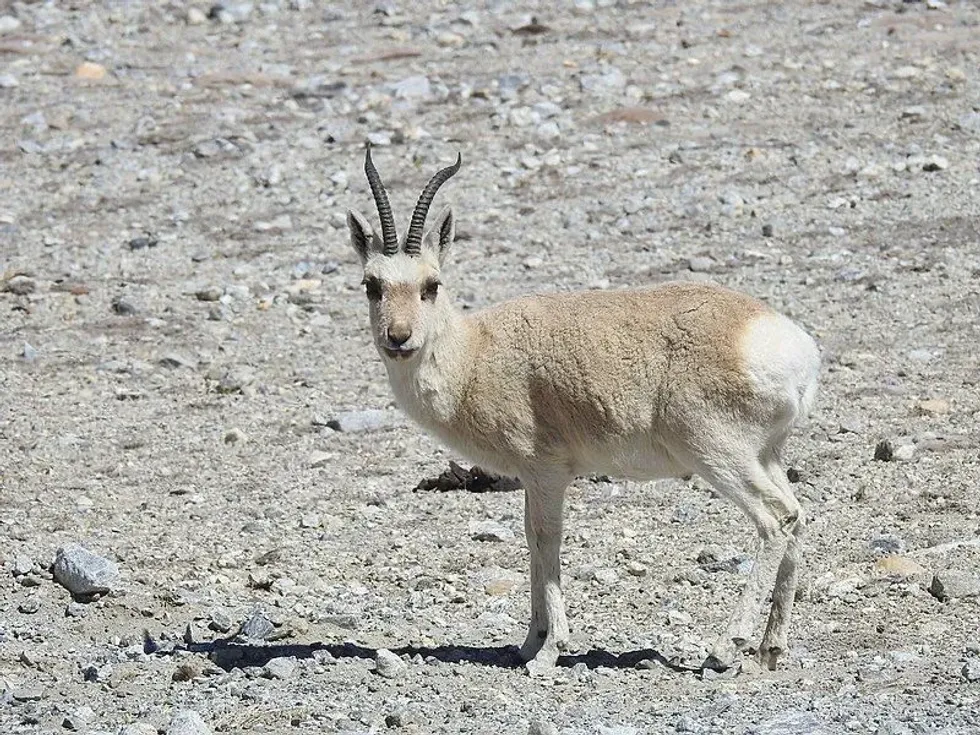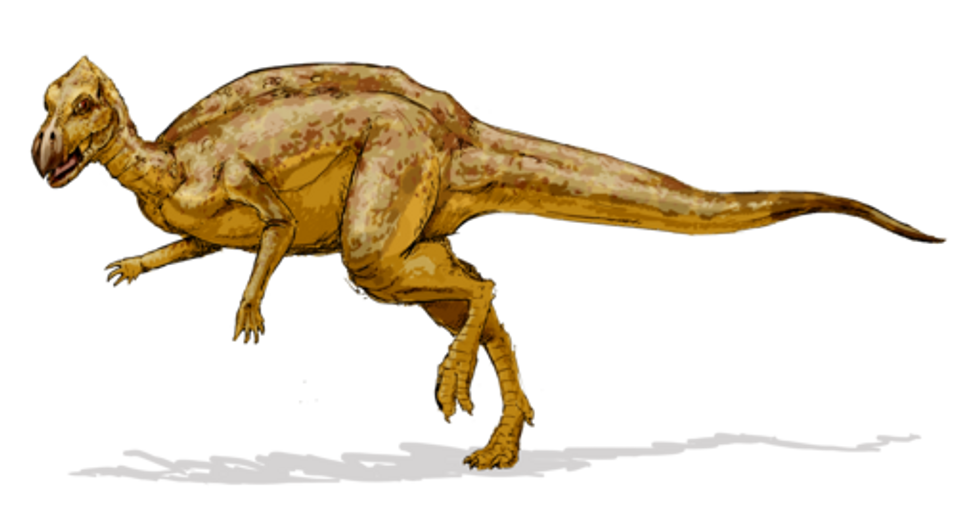The Mongolian gazelle, Procapra gutturosa, is a species of antelope that is indigenous to Mongolia and some regions of China and Siberia. It can be seen in China, the adjacent regions of Kazakhstan, and the Russian Federation.
It belongs to the genus Procapra and is a member of the Bovidae family. Adults of this species range between 55.1-66 lb (25-30 kg) in weight and attain a height of 29.5 in (75 cm).
Only males of this species possess lyre-formed horns. These horns grow backward and can grow up to 15.7 in (40 cm) in length.
The flanks (sides) of this antelope are pink-cinnamon in color and the coloration of its coat varies with the season.
It dwells in tall dry grasslands and undulating or flat steppes in cool temperate zones. It feeds upon grasses, pea shrubs, legumes, and onions and it has been observed to breed between the months of November and February.
The lifespan of this species is significantly less than that of other related ungulates, with males living as long as seven and a half years, and females for nine and a half years. Keep reading to discover more fun facts about the typical Mongolian gazelle distribution, breeding, ecology, behavior, and more!
If you enjoyed reading our Mongolian gazelle fun facts, you must check out our common eland surprising facts and fallow deer interesting facts!
Mongolian Gazelle Interesting Facts
What type of animal is a Mongolian gazelle?
The Mongolian gazelle, Procapra gutturosa, is a medium-sized antelope indigenous to Mongolia. It is indigenous to Mongolia and some regions of China and Siberia.
What class of animal does a Mongolian gazelle belong to?
The Mongolian gazelle, Procapra gutturosa, belongs to class Mammalia.
How many Mongolian gazelles are there in the world?
Populations of these gazelles have declined significantly. The population of these animals was once abundant, at approximately 1,500,000. Currently, their total population in the world is estimated to be 300,000-500,000. This decrease in their population is due to grassland degradation, agricultural development, human expansion, and overgrazing.
Where does a Mongolian gazelle live?
The Mongolian gazelle occurs in cold, temperate semi-arid zones. They prefer flat and dry grasslands. The Mongolian gazelle species was seen across the majority of Mongolia's regions, the adjacent regions of Kazakhstan, in China, and in the Russian Federation until the '50s. Now, we can spot them most commonly in the eastern region of this distribution range.
What is a Mongolian gazelle's habitat?
This species occurs in the cold winters at temperatures of -22 F (-30 C). The Mongolian gazelle lives in tall grasslands in cool temperate zones.
Similar to other antelope species that dwell in arid areas, this antelope can be migratory, nomadic, or even both. It accumulates in herds comprising 6000-8000 individuals in the spring season during its northerly movements. They have the ability to cover 120-180 mi (193.1-289.6 km) in one day during migrations!
Who do Mongolian gazelles live with?
These animals have been observed to dwell in groups. This group can comprise a larger number of individuals in the winter season as compared to the summer season. Their groups are known as herds and can comprise 20-30 animals during the summer, and approximately 100 in the winter. Herds comprising 5,000 individuals also occur and are not uncommon.
How long does a Mongolian gazelle live?
The average Mongolian gazelle lifespan is considerably shorter than that of other related ungulates, with males of this species living only as long as seven and a half years, and females for nine and a half years. The reason for the short Mongolian gazelle life span is believed to be the quick wearing of their teeth.
How do they reproduce?
Mongolian gazelle mating habits are similar to those of gorillas. Their breeding season commences in mid-November and goes on until February.
These mammals exhibit a polygynous nature and one male gazelle is known to mate with around 13 female gazelles. Birthing takes place from mid-June to July and their gestation period is seven months long typically.
Many females isolate from the herd for the purpose of giving birth.
They rejoin their herd after birthing has taken place and they tend to give birth to a single fawn or twins. Female young gazelles of this species attain reproductive maturity at the age of one and a half years and male young gazelles attain it at the age of two and a half years.
What is their conservation status?
They are listed as a species of Least Concern by the IUCN's Red List. They are mainly threatened by hunting, degradation, harvesting, and human-induced habitat loss.
Mongolian Gazelle Fun Facts
What do Mongolian gazelles look like?
These animals are short-sized antelopes that possess pink-cinnamon-colored flanks (sides). The coloration of their coat varies with the season. Their coat has an orange-buff coloration in summers and a paler coat in the winter season.
Only males of this species possess lyre-formed horns. These horns grow backward and can grow up to 15.7 in (40 cm) in length. Adults of this species range between 55.1-66 lb (25-30 kg) in weight and attain a height of 29.5 in (75 cm).
 We've been unable to source an image of a Mongolian gazelle and have used an image of a Tibetan gazelle instead. If you are able to provide us with a royalty-free image of a Mongolian gazelle, we would be happy to credit you. Please contact us at hello@kidadl.com
We've been unable to source an image of a Mongolian gazelle and have used an image of a Tibetan gazelle instead. If you are able to provide us with a royalty-free image of a Mongolian gazelle, we would be happy to credit you. Please contact us at hello@kidadl.com
How cute are they?
These antelopes are quite cute. They have an adorable appearance and they are also known to be quite friendly. However, we should still maintain a safe distance from them as they are wild animals.
How do they communicate?
Not much data is available about how these gazelles communicate with each other. However, we do know that they are believed to communicate primarily via postures and visual signs.
How big is a Mongolian gazelle?
An adult of this species ranges between 3.2-4.2 ft (1-1.3 m) in head-to-rump length and attains a height of 29.5 in (75 cm). The average Mongolian gazelle size is similar to that of Chinese water deer.
How fast can a Mongolian gazelle run?
These antelopes can run at fast speeds ranging between 37.2-40.3 mph (60-65 kph). They also possess the ability to jump up to 19.6 ft (6 m) in the air!
They are excellent swimmers as well and they can cross large rivers. They are also known to cover 120-180 mi (193.1-289.6 km) in one day during migrations that occur in autumn and spring!
How much does a Mongolian gazelle weigh?
They range between 55.1-66 lb (25-30 kg) in weight.
What are their male and female names of the species?
The male is known as a buck and the female is known as a doe.
What would you call a baby Mongolian gazelle?
A Mongolian gazelle calf is called a fawn.
What do they eat?
During winter and summer, grazing occurs throughout the morning as well as in the late afternoon. They feed upon grasses, pea shrubs, legumes, and onions in spring. Onions are a major part of their diet in summers too. At other times, they feed upon grasses.
Are they dangerous?
No, they are not dangerous. However, it would be a wise decision to keep a distance from them as they are truly wild animals.
Would they make a good pet?
No, the Procapra gutturosa can't be a pet as it is a wild animal.
Did you know...
Mongolian gazelles possess abundant microorganisms which aid in recycling the nitrogen gas that is used during the synthesis of protein. These microorganisms prove to be very helpful during winter and autumn when there is a shortage of nitrogen.
A humongous herd of a quarter of a million Mongolian gazelles was once spotted in 2007!
Is a Mongolian gazelle a deer?
No, it is not a deer. Instead, it is an antelope. Deers differ greatly from antelopes, when it comes to their body size, whereas gazelles do not differ significantly. Also, deer are known to shed their branched antlers once a year, whereas the unbranched horns of gazelles are permanent.
What kind of predators live in Mongolia?
The Mongolian wolf is a large predator. It is a species of gray wolf living in Mongolia. Snow leopards, wolves, and brown bears are some other predators living in Mongolia.
Here at Kidadl, we have carefully created lots of interesting family-friendly animal facts for everyone to discover! Learn more about some other mammals from our greater kudu fun facts and argali facts for kids.
You can even occupy yourself at home by coloring in one of our free printable deer coloring pages.
*We've been unable to source an image of a Mongolian gazelle and have used an image of a Tibetan gazelle instead as main image. If you are able to provide us with a royalty-free image of a Mongolian gazelle, we would be happy to credit you. Please contact us at hello@kidadl.com.




 We've been unable to source an image of a Mongolian gazelle and have used an image of a Tibetan gazelle instead. If you are able to provide us with a royalty-free image of a Mongolian gazelle, we would be happy to credit you. Please contact us at hello@kidadl.com
We've been unable to source an image of a Mongolian gazelle and have used an image of a Tibetan gazelle instead. If you are able to provide us with a royalty-free image of a Mongolian gazelle, we would be happy to credit you. Please contact us at hello@kidadl.com




